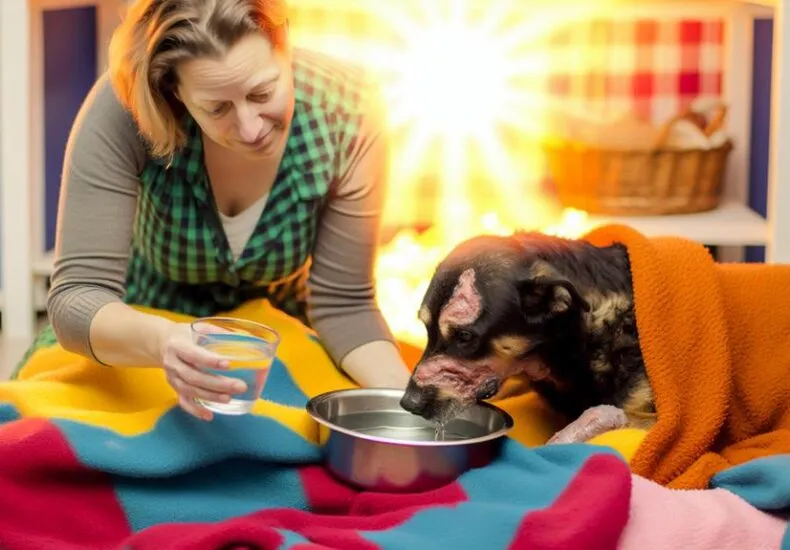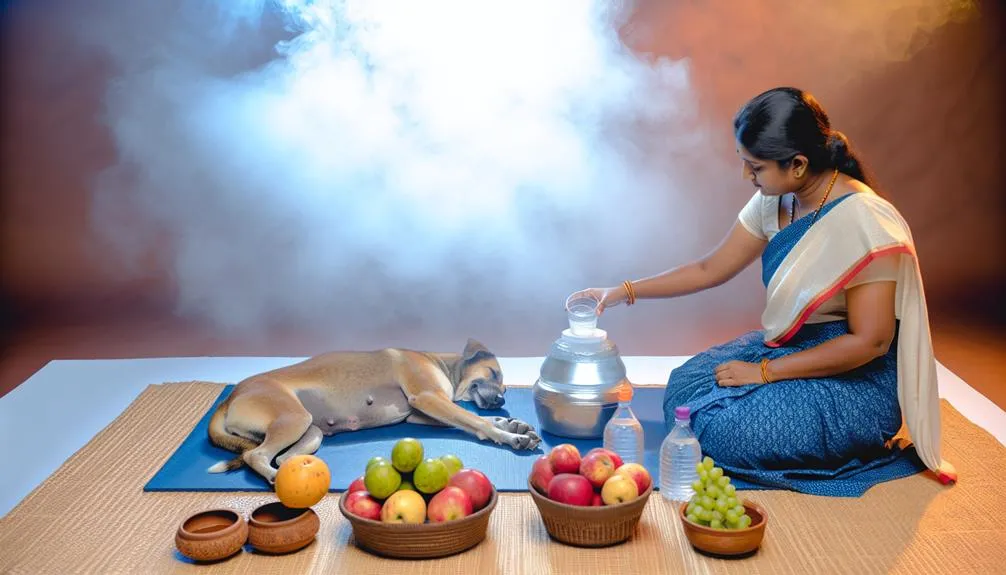
How to Prevent Dehydration in Dog With Burn Wound
Just as a parched desert reveals the vulnerability of life, a dog with burn wounds faces the risk of dehydration, which can complicate its recovery. You might not realize how essential consistent hydration is during this time, and understanding the signs of dehydration can make a significant difference. Implementing effective hydration techniques isn't merely about providing water; it's about nurturing your pet's healing process. What strategies can you employ to guarantee your dog stays hydrated and comfortable?
Understanding Dog Burn Wounds
When a dog suffers a burn wound, it can be a distressing experience for both the pet and its owner. Understanding the nature of burn wounds is essential for effective burn wound care and supporting the healing process. Burns can vary in severity, classified into first, second, and third-degree burns. First-degree burns affect only the outer layer of skin, causing redness and minor pain. Second-degree burns penetrate deeper, leading to blisters and more significant discomfort. Third-degree burns damage all layers of skin and may require extensive medical intervention.
Immediate action is important when addressing a burn wound. Rinse the area gently with cool water to soothe the pain and remove any contaminants. Avoid using ice, as it can cause further tissue damage. After cooling the burn, seek veterinary care to determine the extent of the injury and get appropriate treatment recommendations.
As part of burn wound care, your veterinarian may advise on cleaning the wound, applying topical medications, and using protective bandages. Monitoring the wound for signs of infection, such as increased swelling, redness, or discharge, is crucial. A healthy diet and hydration also play significant roles in the healing process. Ensuring your dog stays hydrated and receives adequate nutrition can enhance their recovery.
Signs of Dehydration in Dogs
Burn wounds can considerably increase a dog's risk of dehydration due to fluid loss and increased metabolic demands during the healing process. Recognizing the signs of dehydration is essential for guaranteeing your dog's well-being, especially when they're dealing with burn wounds. Here are three key signs to look out for:
- Dry Gums: One of the first indicators of dehydration is a change in your dog's gum color. Healthy gums should be moist and pink. If they appear dry or sticky, it's a warning sign that your dog may be dehydrated.
- Lethargy: If you notice your dog is more tired than usual or less responsive to your commands, this change in behavior can be a symptom of dehydration. Increased fatigue often accompanies dehydration, impacting your dog's overall energy levels.
- Loss of Skin Elasticity: You can perform a simple skin pinch test. Gently pinch the skin between your dog's shoulder blades and release it. If the skin doesn't return to its normal position quickly, this could indicate dehydration.
Understanding these signs can help you respond quickly to your dog's needs. Factors contributing to dehydration causes, such as burn wounds, can lead to serious health issues if not addressed promptly. Monitoring your dog's behavior and physical condition can guarantee they receive the care they need during their recovery.
Importance of Hydration

Hydration is vital for your dog's recovery, especially when dealing with burn wounds. Water intake helps maintain bodily functions and supports healing, making it essential to monitor their hydration levels closely. Recognizing the signs of dehydration early can help you take the necessary steps to guarantee your dog's well-being.
Role of Water Intake
Water is essential for all living beings, and this is especially true for dogs with burn wounds. Maintaining proper hydration is critical for healing, as it directly affects water absorption and hydration balance in your dog's body. Here are three key reasons why ensuring adequate water intake is essential:
- Promotes Healing: Sufficient hydration helps to facilitate the healing process by delivering necessary nutrients to damaged tissues, enhancing recovery from burns.
- Regulates Body Temperature: Dogs with burn wounds can struggle to maintain a stable body temperature. Proper water intake aids in thermoregulation, preventing overheating.
- Supports Organ Function: Adequate hydration is crucial for the proper functioning of important organs. It assists in circulation and helps to flush out toxins, thereby supporting overall health.
As a caring pet owner, you should monitor your dog's water intake, ensuring they have constant access to fresh water. If your dog seems reluctant to drink, consider offering ice chips or adding water to their food to encourage hydration. Remember, keeping your dog well-hydrated is a fundamental part of their recovery process.
Signs of Dehydration
Recognizing the signs of dehydration in dogs is essential for their recovery, especially when dealing with burn wounds. Dehydration can greatly hinder healing, so it's important to monitor your dog's condition closely. Here are some common signs to watch for:
| Sign of Dehydration | Description |
|---|---|
| Dry gums | Gums may appear sticky or dry. |
| Loss of skin elasticity | Skin doesn't return quickly when pinched. |
| Lethargy | Your dog may seem unusually tired. |
| Sunken eyes | Eyes may appear sunken or dull. |
| Decreased urine output | Less frequent urination than normal. |
These symptoms can indicate that dehydration is occurring, which can be caused by factors like excessive heat, inadequate water intake, or the stress of a burn injury. To promote effective dehydration prevention, make sure your dog has constant access to fresh water, and monitor their intake regularly. If you notice any signs, consult your veterinarian promptly. Prompt action can make a considerable difference in your dog's recovery journey, so stay vigilant and compassionate in your care.
Monitoring Water Intake
Monitoring your dog's water intake is essential, especially when they're dealing with burn wounds. Proper hydration can greatly aid in their recovery process. Here are three key strategies to help you effectively monitor their water intake:
- Water Bowl Placement: Make sure your dog's water bowl is easily accessible and in a quiet area where they feel safe. This will encourage them to drink more frequently and comfortably. Avoid placing it near their food bowl to prevent distractions.
- Set Hydration Reminders: Create a schedule to remind you to check and refill your dog's water bowl regularly. Dogs may not ask for water, so setting a timer or using an app can help you stay on top of their hydration needs.
- Monitor Water Consumption: Keep track of how much water your dog drinks each day. If you notice a considerable decrease or increase in their intake, it could indicate a problem. Write down their daily consumption to identify any patterns or changes.
Hydration Techniques for Recovery

To support your dog's recovery from burn wounds, incorporating oral hydration solutions and moisture-rich foods can be vital. These techniques not only help maintain hydration levels but also provide essential nutrients for healing. It's important to monitor your dog's response to these methods to guarantee they are effectively aiding in their recovery.
Oral Hydration Solutions
Ensuring adequate hydration is essential for dogs recovering from burn wounds, as dehydration can greatly hinder the healing process. One effective way to maintain hydration is through oral hydration solutions that help restore electrolyte balance. Here are three options you can consider:
- Homemade Electrolyte Solution: You can easily create a homemade solution by mixing water, a pinch of salt, and a small amount of sugar. This helps replenish lost electrolytes and encourages your dog to drink more.
- Commercial Electrolyte Solutions: Look for pet-specific electrolyte solutions available at your local pet store or veterinarian. These are formulated to meet your dog's needs during recovery.
- Flavored Water: If your dog isn't keen on drinking plain water, try adding a small amount of low-sodium chicken or beef broth to encourage hydration. Just make sure it doesn't contain onions or garlic, which can be harmful.
Moisture-Rich Foods
Incorporating moisture-rich foods into your dog's diet can greatly aid in their recovery from burn wounds. These foods not only provide hydration but also offer essential nutrients to support healing. Start with vegetable broths and homemade soups, which can be easily mixed with your dog's regular food. Wet kibble is another excellent option, as it's typically higher in moisture content compared to dry kibble.
Consider adding hydration treats that are specifically formulated to boost water intake. Fruit purees, such as those made from water-rich fruits like watermelon or cucumber, can be a invigorating addition. You might also create broth ice cubes to offer as a cool, tasty snack on warm days.
Yogurt toppings can provide probiotics, promoting digestive health, while canned pumpkin serves as a nutritious filler that's often appealing to dogs. Freeze-dried meals can also be rehydrated to introduce moisture back into their diet. By diversifying your dog's meals with these moisture-rich options, you'll help guarantee they stay hydrated, which is vital for their recovery process. Remember, consult your vet before making any significant dietary changes to guarantee your dog's needs are met.
Nutritional Support for Healing
Nutritional support plays an essential role in the healing process for dogs suffering from burn wounds. Providing the right nutrients can greatly enhance recovery by promoting tissue repair and boosting the immune system. Here are three key components to focus on:
- Proteins: High-quality protein sources are important for tissue regeneration. They help in the formation of new cells and repair damaged tissues. Incorporate lean meats, fish, and eggs into your dog's diet to guarantee they're receiving adequate protein.
- Vitamins and Minerals: Certain vitamins and minerals act as healing nutrients. Vitamin C, for instance, is critical for collagen synthesis, while zinc plays an important role in immune function and skin healing. Consider adding fruits like blueberries or vegetables such as spinach to your dog's meals.
- Nutritional Supplements: Sometimes, it may be beneficial to use nutritional supplements specifically designed for healing. Omega-3 fatty acids can help reduce inflammation and promote skin health. Look for supplements that are veterinarian-approved to make sure they meet your dog's specific needs.
When to Consult a Veterinarian

Recognizing when to consult a veterinarian is essential for the health and recovery of your dog with burn wounds. While providing first aid and initial burn care at home is important, there are specific signs that indicate professional veterinary assistance is necessary. If your dog shows severe pain, excessive swelling, or if the burn appears deep or larger than a quarter, it's vital to seek veterinary help immediately.
You should also consult a veterinarian if you notice any signs of infection, such as discharge, strong odors, or if your dog develops a fever. These symptoms can complicate the healing process and lead to more serious health issues. Additionally, if your dog is experiencing difficulty eating, drinking, or has unusual lethargy, these may signal dehydration or other complications that require medical attention.
It's also wise to consult your veterinarian if you're unsure about the best course of action for your dog's burn care. They can provide guidance on appropriate treatments and medications to manage pain and prevent infection. Regular check-ups may also be necessary to monitor the healing process.
Frequently Asked Questions
Can Burns Cause Long-Term Dehydration Issues in Dogs?
Yes, burn severity can lead to long-term dehydration issues in dogs. During the healing process, fluid loss can be significant. It's essential to monitor hydration levels and consult your vet for appropriate care.
Are Certain Dog Breeds More Prone to Dehydration?
Certain breeds, like Greyhounds, can struggle with hydration more than others. You should watch for dehydration symptoms like lethargy or dry gums. Ensuring proper breed hydration is essential for your dog's overall health and well-being.
How Does Temperature Affect a Dog's Water Needs?
Temperature greatly impacts your dog's water intake. Higher temperatures increase their need for hydration to maintain temperature regulation, while lower temperatures may reduce it. Always make sure fresh water is available, especially during warmer weather.
Can I Use Flavored Water to Encourage My Dog to Drink?
Yes, you can use flavored water to encourage your dog to drink. Flavored water benefits include enhancing taste, making hydration alternatives more appealing, which can help guarantee your dog stays adequately hydrated, especially during recovery.
What Environmental Factors Increase Dehydration Risk for My Dog?
Heat exposure and high humidity levels increase your dog's dehydration risk considerably. When temperatures rise, ventilation decreases, and moisture levels fluctuate, it's essential to monitor your pet's water intake and overall hydration regularly.
Conclusion
In the journey of healing your dog's burn wounds, hydration acts as the lifeblood that fuels recovery. Just as a plant needs water to flourish, your dog requires consistent access to fluids to thrive. Keep a watchful eye on their water intake, and don't hesitate to try different hydration techniques to encourage drinking. Remember, your veterinarian is your trusted guide in this process, ensuring that your furry friend stays healthy and comfortable during their recovery.
You may also like
Archives
Calendar
| M | T | W | T | F | S | S |
|---|---|---|---|---|---|---|
| 1 | 2 | 3 | 4 | 5 | 6 | |
| 7 | 8 | 9 | 10 | 11 | 12 | 13 |
| 14 | 15 | 16 | 17 | 18 | 19 | 20 |
| 21 | 22 | 23 | 24 | 25 | 26 | 27 |
| 28 | 29 | 30 | ||||
Leave a Reply